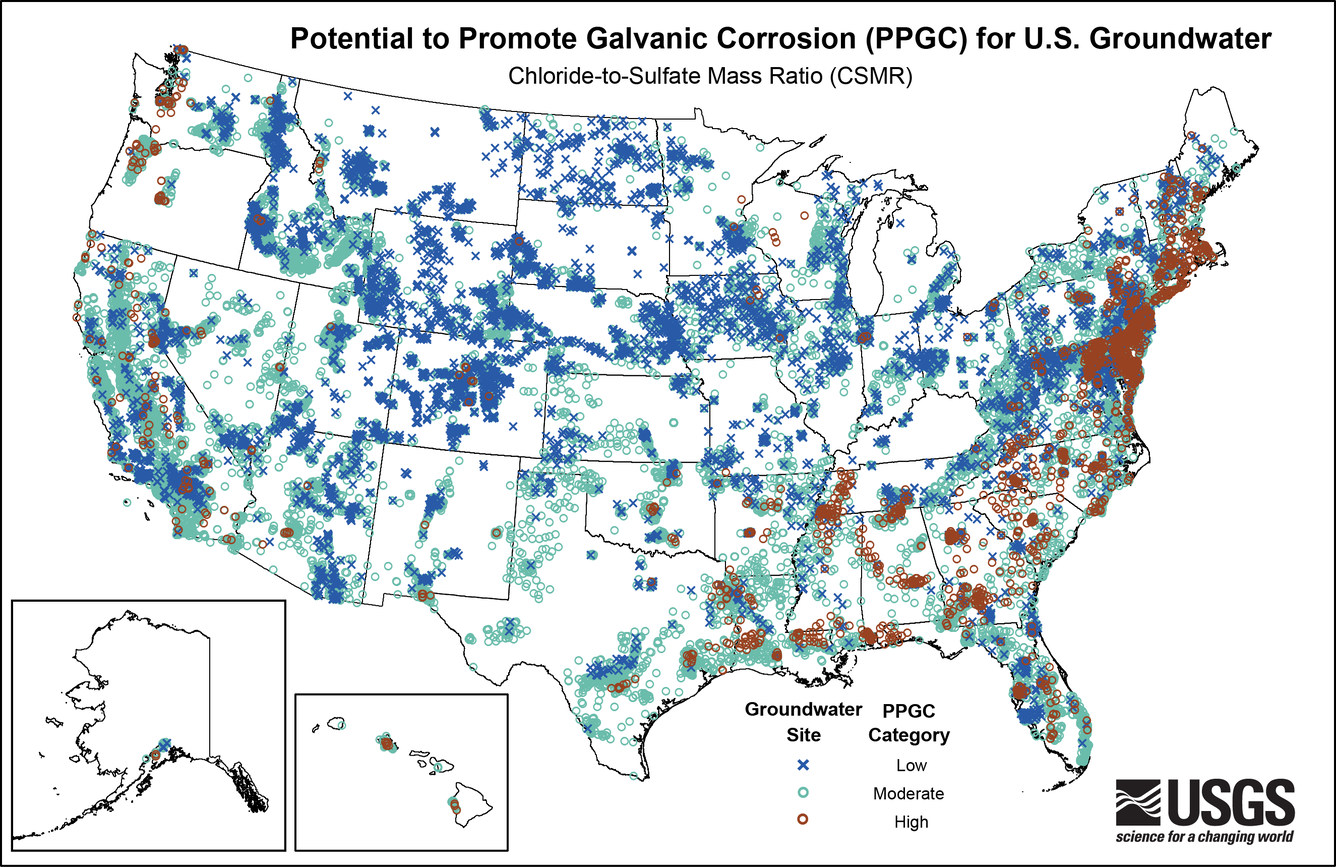New Study Shows High Potential for Corrosive Groundwater in 25 States
USGS Analyzed More Than 20,000 Wells Nationwide
An analysis of more than 20,000 wells nationwide shows 25 states have groundwater that has either high or very high potential to be corrosive...
A new U.S. Geological Survey assessment of more than 20,000 wells nationwide shows that untreated groundwater in 25 states has a high prevalence of being potentially corrosive. The states with the largest percentage of wells with potentially corrosive groundwater are located primarily in the Northeast, the Southeast, and the Northwest.
This report is unrelated to the drinking water problems experienced in Flint, Michigan. The problems in Flint were related to treated surface-water from the Flint River, whereas this report focuses on untreated groundwater nationwide.
Two indicators of potential corrosivity were combined to determine that corrosive groundwater occurs in all 50 states and the District of Columbia. Corrosive groundwater, if untreated, can dissolve lead and other metals from pipes and plumbing fixtures.
“The corrosivity of untreated groundwater is only one of several factors that may affect the quality of household drinking water at the tap,” said Stephen Moulton II, chief, USGS National Water-Quality Program. “Nevertheless, it is an essential factor that should be carefully considered in testing for water quality in both public and private supplies nationwide.”
Public water supplies are regulated by the U.S. EPA, but maintenance, testing and treatment of private water supplies are the sole responsibility of the homeowner. About 44 million people in the U.S. get their drinking water from private wells, yet surveys indicate many homeowners are unaware of some basic testing that should be done to help ensure safe drinking water in the home.
“Fortunately, in most areas of the country and with appropriate safeguards, the majority of homeowners can get good quality drinking water from private wells,” said Moulton. “But this study is a good reminder that prudent, routine testing of the water, including its interaction with the water supply system, is an essential first step so homeowners and their families can confidently drink water from their faucets.”
Naturally corrosive water is not dangerous to consume by itself, however it can cause health-related problems by reacting with pipes and plumbing fixtures in homes. If plumbing materials contain lead or copper, these metals may be leached into the water supply by corrosive water. Signs of corrosive water causing leaching of metals may include bluish-green stains in sinks, metallic taste to water, and small leaks in plumbing fixtures.
Potential sources of lead in homes include:
- lead pipes or fittings used in homes built prior to 1930
- lead solder used in copper fittings in homes built prior to the late 1980s
- “lead-free” brass components, which, in all states, except California, may have contained up to 8 percent lead, prior to 2014
- galvanized steel that contained 0.5 to 1.4 percent lead, prior to 2014
“USGS has consistently monitored the water quality of the Nation’s groundwater for over three decades by analyzing representative water samples,” said Moulton. “Recent public health and water quality issues underscore the responsibility for us to report the possibility that regional geologic characteristics of groundwater could potentially affect household water systems resulting in significant implications for public health.”
For concerns about potential health effects of household drinking water, the USGS looks to federal and state agencies to provide an indication of the potential scope of the problem.
For example, Virginia and Pennsylvania are states where private water sources, such as wells, springs, or cisterns, are especially common. Private water systems are used by about 1.7 million people in Virginia and about 3 million people in Pennsylvania.
In these states, the Virginia Household Water Quality Program and the Pennsylvania Master Well Owner Network provide practical information to homeowners about maintaining, testing, and protecting private water systems. University researchers at Virginia Tech and Penn State work with these specialized programs to monitor the quality of drinking water supplied by private water systems and to provide testing and advice to identify and remediate water-quality problems caused by contaminated or corrosive groundwater.
“Between 2012 and 2014, we found that 19 percent of the 2,144 private water systems sampled in Virginia exceeded the EPA lead action level,” said Dr. Kelsey Pieper, USDA-NIFA Postdoctoral Fellow at Virginia Tech. “We also observed that ‘lead-free’ plumbing components released lead when exposed to more corrosive groundwater supplies.”
“In Pennsylvania, corrosive water is usually associated with certain types of bedrock geology but can be found across the entire state,” said Bryan Swistock, a water resources specialist with Penn State Extension. “Lead levels exceeded the EPA action level in 12 percent of the 251 drinking water systems monitored in Pennsylvania in 2007.”
The USGS report, “Assessing the Potential Corrosivity of U.S. Groundwater” can be found online. Additional information on groundwater quality monitoring and modeling is available on the USGS National Water-Quality Assessment project website. A new USGS online mapper provides a decadal look at groundwater quality.




